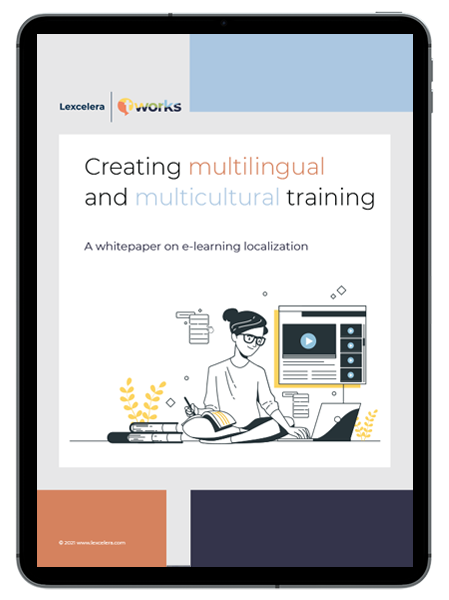
Following our post on “Why localize your training program?“, find out the best practices and tools to use for efficient localization.
E-learning localization can be a complex task. Planning will make it more predictable, eliminate errors, and improve and sustain quality. Below, we list some recommendations to localize your online training materials in an optimum way:
Best practices for e-learning localization
1. Localization needs to keep up with the course development. That way, localization takes the least amount of time, effort, and money. If localization is only added as an afterthought, at the very least it can take more time to complete. At worst, you might even have to re-do parts or all of the program. For instance, if you have used a theme in your e-learning course and woven the entire course using that theme. If this theme makes no sense in the target market, you’d then have to re-do the entire program.
2. Get inputs from stakeholders. Identify your audience and understand their learning needs. What format would they prefer the learning modules to be in? On what skills would they like to be trained? How about the length of the course? Which language would they prefer the training to be in? On which device would they take the course? It’s best to get their inputs when beginning to develop the course, so as to ensure maximum engagement.
3. Determine your translation approach. Translation can be done in three different ways: entirely by a machine, by humans, or with a hybrid approach where humans
work with machine output and improve it. Usually, for e-learning, it’s either completely translated by professional translators or a hybrid approach is adopted. A pure machine translation (MT) approach may not be suitable and is not recommended.
4. Select your translation technology tools. The translation tech landscape is nowadays very diverse and complex. Choose the tools that would work best with the learning management systems (LMS) that you might be using. See next section for more details.
5. Work with an experienced and knowledgeable language services agency. The agency must be available to provide all the services required for e-learning localization, and not just translation. E-learning might take many forms, including virtual conferences. Here, additional services such as automated transcription and voice over would be required. The agency must be able to handle the services that are required for media localization, work with efficient tools, and provide round-the-clock project management.
Tools to use for efficient localization
LMSes have now evolved to adapt to localization requirements. Here we mention some of the widely used tools in the industry.
Articulate StoryLine: With this tool, you can create one course with multiple languages. One way it does this is the branching method where the learner is asked for their language preference at the start of the course. The other method is to use layers so that you can offer different languages in a single StoryLine file. StoryLine can be very efficiently used to translate PPTs, edit audio, and hold multilingual virtual training sessions.
Crossknowledge Mohive: It’s an e-learning authoring tool that features multi-language translation through XLIFF exports and imports. The translators are able to see the context of the words, thus enabling more accurate and faster translation.
Other tools that are great with learning content localization are Adobe Captivate and Trivantis Lectora, to name just a few.
Several translation technology solutions are either built into these tools or need to be plugged in. Some solutions are important to control budget, increase speed, and maintain quality.
Translation memory: This is a tool that saves all previously translated sentences (strings) in a database. As new content comes up for translation, this tool instantly recognizes words, phrases, or sentences that may have already been translated and approved. It populates them on the screen, so that the translator doesn’t need to translate them again.
Terminology management: You might have terms that are unique to your organization in your training content. Or maybe terms that are used uniquely and hence the meaning must be retained as such in the translated content. Perhaps you do not want to translate brand names. You might have to add new terms as your company launches new products or retire some terms when they are no longer relevant. All of this and more can be done through terminology management tools. However, a trained linguist must maintain the term database.
Project management capabilities: The LMS must be able to support several professionals working on the file simultaneously. The project manager must be able to assign different parts of the project to voice artists, translators, proofreaders, reviewers, video editors, graphic artists, image editors, developers, and so on. The project manager must also be able to easily see the progress, flag delays, and interact freely with anyone working on the file.
Localizing a training program for employees around the world comes with certain challenges.
Vijayalaxmi Hegde











